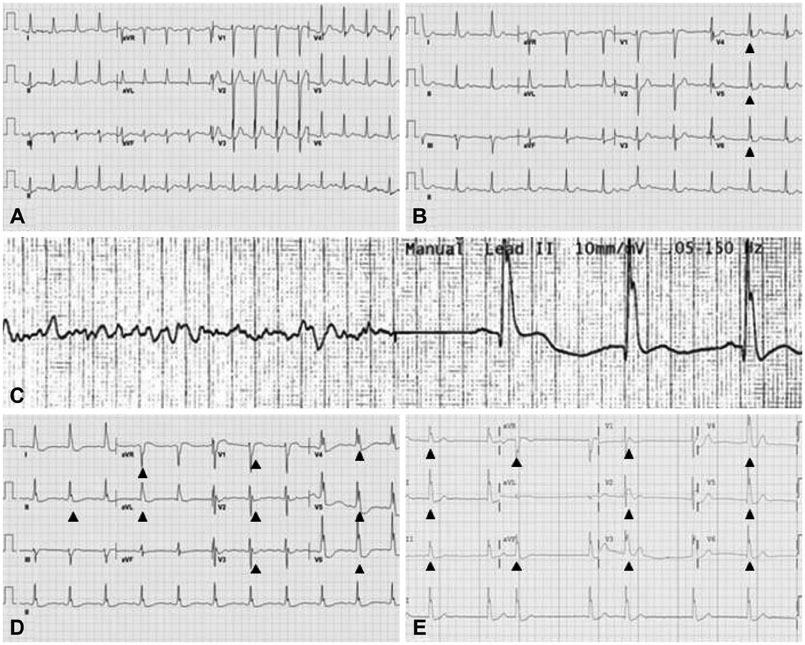Korean Circ J.
2015 Jan;45(1):81-84. 10.4070/kcj.2015.45.1.81.
Case of Recurrent Ventricular Fibrillations with Osborn Wave Developed during Therapeutic Hypothermia
- Affiliations
-
- 1Department of Internal Medicine, Kyungpook National University Hospital, Daegu, Korea. bmh0325@knu.ac.kr
- KMID: 2223851
- DOI: http://doi.org/10.4070/kcj.2015.45.1.81
Abstract
- Therapeutic hypothermia (TH) has been used to protect neurological functions in cardiac arrest patient. Although Osborn wave is not pathognomonic of hypothermia, it is a well-known electrocardiogram finding of hypothermic patients. The cellular and ionic mechanisms of the Osborn wave have been suggested, and its relationship to tachyarrhythmias, such as ventricular tachycardia and ventricular fibrillation, is being explored. This case highlights the arrhythmogenic potential of Osborn wave and individual difference in response of TH.
MeSH Terms
Figure
Cited by 1 articles
-
Therapeutic Hypothermia for Cardioprotection in Acute Myocardial Infarction
In Sook Kang, Ikeno Fumiaki, Wook Bum Pyun
Yonsei Med J. 2016;57(2):291-297. doi: 10.3349/ymj.2016.57.2.291.
Reference
-
1. Bernard SA, Gray TW, Buist MD, et al. Treatment of comatose survivors of out-of-hospital cardiac arrest with induced hypothermia. N Engl J Med. 2002; 346:557–563.2. Hypothermia after Cardiac Arrest Study Group. Mild therapeutic hypothermia to improve the neurologic outcome after cardiac arrest. N Engl J Med. 2002; 346:549–556.3. Moore EM, Nichol AD, Bernard SA, Bellomo R. Therapeutic hypothermia: benefits, mechanisms and potential clinical applications in neurological, cardiac and kidney injury. Injury. 2011; 42:843–854.4. Safar PJ, Kochanek PM. Therapeutic hypothermia after cardiac arrest. N Engl J Med. 2002; 346:612–613.5. Janata A, Holzer M. Hypothermia after cardiac arrest. Prog Cardiovasc Dis. 2009; 52:168–179.6. Vassallo SU, Delaney KA, Hoffman RS, Slater W, Goldfrank LR. A prospective evaluation of the electrocardiographic manifestations of hypothermia. Acad Emerg Med. 1999; 6:1121–1126.7. Haïssaguerre M, Derval N, Sacher F, et al. Sudden cardiac arrest associated with early repolarization. N Engl J Med. 2008; 358:2016–2023.8. Cappato R, Furlanello F, Giovinazzo V, et al. J wave, QRS slurring, and ST elevation in athletes with cardiac arrest in the absence of heart disease: marker of risk or innocent bystander? Circ Arrhythm Electrophysiol. 2010; 3:305–311.9. Tikkanen JT, Anttonen O, Junttila MJ, et al. Long-term outcome associated with early repolarization on electrocardiography. N Engl J Med. 2009; 361:2529–2537.10. Rosso R, Kogan E, Belhassen B, et al. J-point elevation in survivors of primary ventricular fibrillation and matched control subjects: incidence and clinical significance. J Am Coll Cardiol. 2008; 52:1231–1238.11. Rolfast CL, Lust EJ, de Cock CC. Electrocardiographic changes in therapeutic hypothermia. Crit Care. 2012; 16:R100.12. Graham CA, McNaughton GW, Wyatt JP. The electrocardiogram in hypothermia. Wilderness Environ Med. 2001; 12:232–235.13. Okada M. The cardiac rhythm in accidental hypothermia. J Electrocardiol. 1984; 17:123–128.14. Mustafa S, Shaikh N, Gowda RM, Khan IA. Electrocardiographic features of hypothermia. Cardiology. 2005; 103:118–119.15. Antzelevitch C, Yan GX. J wave syndromes. Heart Rhythm. 2010; 7:549–558.16. Yan GX, Antzelevitch C. Cellular basis for the electrocardiographic J wave. Circulation. 1996; 93:372–379.17. Maruyama M, Kobayashi Y, Kodani E, et al. Osborn waves: history and significance. Indian Pacing Electrophysiol J. 2004; 4:33–39.18. Emslie-Smith D, Sladden GE, Stirling GR. The significance of changes in the electrocardiogram in hypothermia. Br Heart J. 1959; 21:343–351.19. Piktel JS, Jeyaraj D, Said TH, Rosenbaum DS, Wilson LD. Enhanced dispersion of repolarization explains increased arrhythmogenesis in severe versus therapeutic hypothermia. Circ Arrhythm Electrophysiol. 2011; 4:79–86.
- Full Text Links
- Actions
-
Cited
- CITED
-
- Close
- Share
- Similar articles
-
- Clinical Characteristics of Hypothermia with Osborn Wave on ECG Based on the Analysis of 5 Patients
- Successful Treatment of Accidental Hypothermia with Injury: A Case Report
- Recurrent Pulseless Ventricular Tachycardia Induced by Commotio Cordis Treated with Therapeutic Hypothermia
- The Effects of Propranolol and MJ 1999 against Ventricular Fibrillation during Piofound Hypothermia in Dogs
- Profound hypothermia and cardiopulmonary bypass in the treatment of recurrent giant angioblastic meningioma case report




